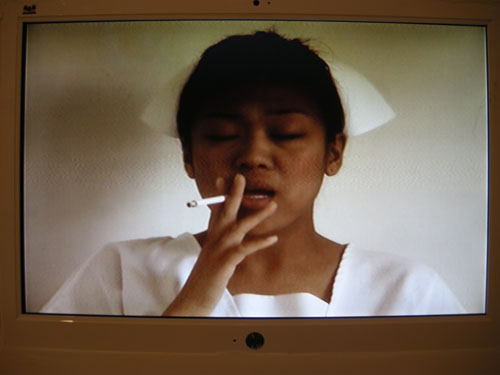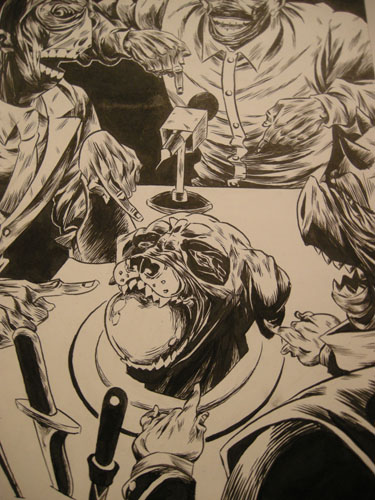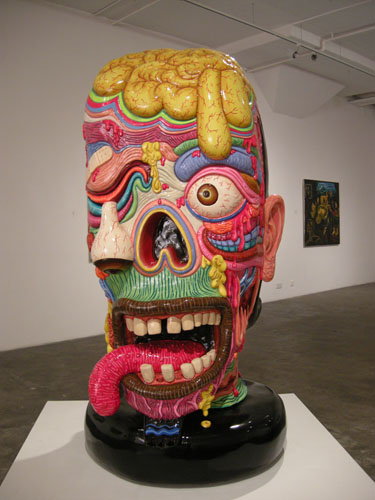藝評
Futuramanila at Osage Kwun Tong
約翰百德 (John BATTEN)
at 5:50pm on 6th October 2008



'Fragments for the Apocalypse'
By John Batten
Originally published in 'C-for-Culture', October 2008
“Broken bones of concrete & metal, wreckage of wires & lives, heretic radio frequency, astral chants, distress signals, graveyards of decrepit Taiwanese buses, interminable lines for non-potable water & mysterious canned meat. This moment is saturated in strange music, like the sound of falling satellites. A vague notion of the sea & its varying permutations of violence. "
from 'The Pancreas Is Deceitful Above All Things (33 Fragments for The Apocalypse)' by Lourd De Veyra, an essay written for Futuramanila.
Somehow, something happened between the issuing of a press release using the above excerpt from a long essay by Lourd De Veyra and the actual opening of Futuramanila at Osage Kwun Tong.
I usually ignore press releases announcing art exhibitions as, apart from salient facts, they often offer little more of interest. However, for Futuramanila I was a member of a discussion panel that Osage Gallery organized about this exhibition of young Filipino artists, and was given material and curatorial information to help prepare for the talk.
De Veyra’s essay is an evocative ramble of verbal images about Manila, the capital of the Philippines. It was specially written for the exhibition and is “a fictional short story in lieu of the usual curator's note” (1). Its intention appears to set the scene for the entire exhibition by offering snippets of Manila’s Spanish and American colonial past and describing the desperate decrepitude of the city’s slums, as well as the present-day official neglect that is of such magnitude that they are, as said, “fragments for the apocalypse”.
Despite the central role this essay plays in the exhibition, copies of De Veyra’s essay were not available for exhibition visitors, and it was not uploaded onto the Osage website. The essay would, and I am sure will, be published in a future catalogue for the exhibition. The original idea of this exhibition was to present Manila as an artistic “storyline” running from its pre-colonial origins to its future and – due to its dysfunctional present – on towards its supposed apocalyptic demise: hence the ‘Futuramanila’ title of the show.
Was there a last-minute recant of the intentions of this exhibition?
Commercial galleries are not constrained by stringent, curatorial guidelines when exhibiting art. The objective of a commercial gallery is simply to sell. However, I believe, Osage has higher intentions and wishes to be considered more than just a commercial art gallery, so the difference between the earlier expressed intentions and the final seen exhibition is confusing. Adding to future confusion will be an exhibition catalogue containing a significant essay that actually plays no role in the actual exhibition.
The gallery has gone to extraordinary lengths to present an engaging exhibition. It showcases the work of 23 up-and-coming Philippine artists, flying many in from Manila to experience Hong Kong. It also opened the exhibition with a performance by the jazz-rave Filipino band Radioactive Sago Project, especially flown in for the event.
This is an elaborately organised exhibition that suffers from mixed messages of artistic intentions. The problem could simply have been resolved by having an identifiable curator: someone who takes responsibility for the intellectual presentation of the exhibition. A similar criticism was made (in a meet-the-artists discussion) about Osage’s previous exhibition, Women’s Work. Osage’s ‘corporate-management’ organization of exhibitions will continue to limit the critical acknowledgement that many of its exhibitions warrant.
Two of ‘Futuramanila’s’ participating artists, Gary Ross Pastrana and Louie Cordero, who initiated and organized this combination of participating artists were constrained by the unavailability of other artists whose Manila gallery objected, in a whim of inter-gallery rivalry, to their participation in this exhibition. This may be one reason why the ‘apocalypse’ angle proposed for the exhibition has, through circumstance, become muted.
Many of the artists shown in Futuramanila began exhibiting in Manila’s artist-run spaces including Surrounded by Water, Future Prospects and Big Sky Mind (all opened and closed over the last seven years) and, more recently, at a variety of semi-commercial spaces, such as Green Papaya and Magnet. Each space is deliberately situated in the outer-urban Quezon City area where these artists predominantly studied and live, far from Manila’s established art hubs of Malate, Ermita and Makati. These simple spaces were converted shops or warehouses, rough and low cost: perfect for aspiring artists with creative and offbeat ideas. Futuramanila would have benefited greatly by importing a little of the spirit of these artists’ origins: unrestrained grunge and some low-down grit in a corner would have balanced out Kwun Tong’s clean industrial look. Victor Balanon’s large mural 'Manifesto Destino Vastardos', completed in four days on site, and his stark series of pen cartoons 'Los Indios Gagos', indicate a little of Manila’s edge and dire energy.
Futuramanila also includes artists from the Philippine diaspora – three of the U.S.-based Filipino artists’ work was exemplary: Stephanie Syjuco’s 'Body Double', Bea Camacho’s 'Efface' and Jenifer K. Wofford’s 'Bad Nurses'. Wofford’s video ostensibly shows inconsequential images of two Filipino nurses relaxing during a break in their work. But the title of the video conjures another meaning and the disparate sequences, each introduced to the viewer by a simple printed sign – in French! - indicates a significance that is not really there. We see these two women larking about; idly having a cigarette, laughing over a sequence in a love-story pocketbook, “…whoa, this one has porn…” and then playing, gloved and sweaty with boxing punch bags and each other. It is just two young women having fun during a work break, but the video is a smart flip on the idea that ‘outsiders’ can think the unintended in the most innocent of actions.
Mac Valdezco uses rolled coils of cotton tape to show intriguing work harking back to a Russian-European constructivist tradition. In contrast, Stanley Ruiz’s small sound, electronic and found object constructions have an entirely appropriate low-fi feel that triggers associations more with Joseph Cornell boxes and Joseph Beuys performances than with the interactive press-the-button objects that they are. Ruiz’s adjacent video Ark, of himself and friends jamming is a contrast of annoying techno-industrial scratchiness that unfortunately permeates the entire exhibition.
Louie Cordero’s large sculpture 'Having Reached Climax at the Age 28…I am a Zombie' is exactly as the title suggests; a three-dimensional sculptural rendition depicting Cordero’s lurid and sexual obsessions and a haughty comic-book humour. In contrast, Yason Banal’s 'Doom Light' is an elaborate chandelier-like light using a Philippine shell, the capiz – which is much used in kitsch decorative household objects and as a traditional opaque window fitting. Banal has painted the entire chandelier in black; defeating its use as lighting and offering a Satan’s chiaroscuro.
An artist’s mortality is tested by Alvin Zafra who uses the lead tip of a live bullet to scratch out a series of portraits on black sandpaper, each portrait using one complete bullet. An endurance of another type is his abstract 'Argument from Nowhere', a long series of joined panels that looks like a monochromatic drawing. Zafra has, instead, manually rubbed a complete human skull onto these panels of sandpaper – this macabre knowledge makes the work, at one moment seemingly banal, take on an impressive resonance about life, death and energy spent in rubbing a skull down to dust; to nothing.
Futuramanila is a good overview of a significant section of current contemporary art trends in the Philippines. The exhibition demonstrates the wider interests of these younger artists tired of the social realism dominance of the generation of artists before them who were profoundly influenced by martial law, American pop culture, the blight of over-population, urban decay and low economic development. The Philippines is the same, the artistic response different.
Notes:
1. Discussion notes prepared by Eileen Legaspi-Ramirez, moderator of the roundtable discussion held at Osage Kwun Tong on 5 September 2008. Exhibition information given to viewers was elaborate and included extensive artist and artwork information written by Ronald Achacoso and available in English and Chinese.
Exhibition: Futuramanila
Date: 5.9 – 6.10.2008
Venue: Osage Kwun Tong
Address: 5/F, Kian Dai Industrial Building, 73-75 Hung To Road, Kwun Tong, Kowloon.
Enquiries: 852 - 27934817
Website: http://www.osagegallery.com/
By John Batten
Originally published in 'C-for-Culture', October 2008
“Broken bones of concrete & metal, wreckage of wires & lives, heretic radio frequency, astral chants, distress signals, graveyards of decrepit Taiwanese buses, interminable lines for non-potable water & mysterious canned meat. This moment is saturated in strange music, like the sound of falling satellites. A vague notion of the sea & its varying permutations of violence. "
from 'The Pancreas Is Deceitful Above All Things (33 Fragments for The Apocalypse)' by Lourd De Veyra, an essay written for Futuramanila.
Somehow, something happened between the issuing of a press release using the above excerpt from a long essay by Lourd De Veyra and the actual opening of Futuramanila at Osage Kwun Tong.
I usually ignore press releases announcing art exhibitions as, apart from salient facts, they often offer little more of interest. However, for Futuramanila I was a member of a discussion panel that Osage Gallery organized about this exhibition of young Filipino artists, and was given material and curatorial information to help prepare for the talk.
De Veyra’s essay is an evocative ramble of verbal images about Manila, the capital of the Philippines. It was specially written for the exhibition and is “a fictional short story in lieu of the usual curator's note” (1). Its intention appears to set the scene for the entire exhibition by offering snippets of Manila’s Spanish and American colonial past and describing the desperate decrepitude of the city’s slums, as well as the present-day official neglect that is of such magnitude that they are, as said, “fragments for the apocalypse”.
Despite the central role this essay plays in the exhibition, copies of De Veyra’s essay were not available for exhibition visitors, and it was not uploaded onto the Osage website. The essay would, and I am sure will, be published in a future catalogue for the exhibition. The original idea of this exhibition was to present Manila as an artistic “storyline” running from its pre-colonial origins to its future and – due to its dysfunctional present – on towards its supposed apocalyptic demise: hence the ‘Futuramanila’ title of the show.
Was there a last-minute recant of the intentions of this exhibition?
Commercial galleries are not constrained by stringent, curatorial guidelines when exhibiting art. The objective of a commercial gallery is simply to sell. However, I believe, Osage has higher intentions and wishes to be considered more than just a commercial art gallery, so the difference between the earlier expressed intentions and the final seen exhibition is confusing. Adding to future confusion will be an exhibition catalogue containing a significant essay that actually plays no role in the actual exhibition.
The gallery has gone to extraordinary lengths to present an engaging exhibition. It showcases the work of 23 up-and-coming Philippine artists, flying many in from Manila to experience Hong Kong. It also opened the exhibition with a performance by the jazz-rave Filipino band Radioactive Sago Project, especially flown in for the event.
This is an elaborately organised exhibition that suffers from mixed messages of artistic intentions. The problem could simply have been resolved by having an identifiable curator: someone who takes responsibility for the intellectual presentation of the exhibition. A similar criticism was made (in a meet-the-artists discussion) about Osage’s previous exhibition, Women’s Work. Osage’s ‘corporate-management’ organization of exhibitions will continue to limit the critical acknowledgement that many of its exhibitions warrant.
Two of ‘Futuramanila’s’ participating artists, Gary Ross Pastrana and Louie Cordero, who initiated and organized this combination of participating artists were constrained by the unavailability of other artists whose Manila gallery objected, in a whim of inter-gallery rivalry, to their participation in this exhibition. This may be one reason why the ‘apocalypse’ angle proposed for the exhibition has, through circumstance, become muted.
Many of the artists shown in Futuramanila began exhibiting in Manila’s artist-run spaces including Surrounded by Water, Future Prospects and Big Sky Mind (all opened and closed over the last seven years) and, more recently, at a variety of semi-commercial spaces, such as Green Papaya and Magnet. Each space is deliberately situated in the outer-urban Quezon City area where these artists predominantly studied and live, far from Manila’s established art hubs of Malate, Ermita and Makati. These simple spaces were converted shops or warehouses, rough and low cost: perfect for aspiring artists with creative and offbeat ideas. Futuramanila would have benefited greatly by importing a little of the spirit of these artists’ origins: unrestrained grunge and some low-down grit in a corner would have balanced out Kwun Tong’s clean industrial look. Victor Balanon’s large mural 'Manifesto Destino Vastardos', completed in four days on site, and his stark series of pen cartoons 'Los Indios Gagos', indicate a little of Manila’s edge and dire energy.
Futuramanila also includes artists from the Philippine diaspora – three of the U.S.-based Filipino artists’ work was exemplary: Stephanie Syjuco’s 'Body Double', Bea Camacho’s 'Efface' and Jenifer K. Wofford’s 'Bad Nurses'. Wofford’s video ostensibly shows inconsequential images of two Filipino nurses relaxing during a break in their work. But the title of the video conjures another meaning and the disparate sequences, each introduced to the viewer by a simple printed sign – in French! - indicates a significance that is not really there. We see these two women larking about; idly having a cigarette, laughing over a sequence in a love-story pocketbook, “…whoa, this one has porn…” and then playing, gloved and sweaty with boxing punch bags and each other. It is just two young women having fun during a work break, but the video is a smart flip on the idea that ‘outsiders’ can think the unintended in the most innocent of actions.
Mac Valdezco uses rolled coils of cotton tape to show intriguing work harking back to a Russian-European constructivist tradition. In contrast, Stanley Ruiz’s small sound, electronic and found object constructions have an entirely appropriate low-fi feel that triggers associations more with Joseph Cornell boxes and Joseph Beuys performances than with the interactive press-the-button objects that they are. Ruiz’s adjacent video Ark, of himself and friends jamming is a contrast of annoying techno-industrial scratchiness that unfortunately permeates the entire exhibition.
Louie Cordero’s large sculpture 'Having Reached Climax at the Age 28…I am a Zombie' is exactly as the title suggests; a three-dimensional sculptural rendition depicting Cordero’s lurid and sexual obsessions and a haughty comic-book humour. In contrast, Yason Banal’s 'Doom Light' is an elaborate chandelier-like light using a Philippine shell, the capiz – which is much used in kitsch decorative household objects and as a traditional opaque window fitting. Banal has painted the entire chandelier in black; defeating its use as lighting and offering a Satan’s chiaroscuro.
An artist’s mortality is tested by Alvin Zafra who uses the lead tip of a live bullet to scratch out a series of portraits on black sandpaper, each portrait using one complete bullet. An endurance of another type is his abstract 'Argument from Nowhere', a long series of joined panels that looks like a monochromatic drawing. Zafra has, instead, manually rubbed a complete human skull onto these panels of sandpaper – this macabre knowledge makes the work, at one moment seemingly banal, take on an impressive resonance about life, death and energy spent in rubbing a skull down to dust; to nothing.
Futuramanila is a good overview of a significant section of current contemporary art trends in the Philippines. The exhibition demonstrates the wider interests of these younger artists tired of the social realism dominance of the generation of artists before them who were profoundly influenced by martial law, American pop culture, the blight of over-population, urban decay and low economic development. The Philippines is the same, the artistic response different.
Notes:
1. Discussion notes prepared by Eileen Legaspi-Ramirez, moderator of the roundtable discussion held at Osage Kwun Tong on 5 September 2008. Exhibition information given to viewers was elaborate and included extensive artist and artwork information written by Ronald Achacoso and available in English and Chinese.
Exhibition: Futuramanila
Date: 5.9 – 6.10.2008
Venue: Osage Kwun Tong
Address: 5/F, Kian Dai Industrial Building, 73-75 Hung To Road, Kwun Tong, Kowloon.
Enquiries: 852 - 27934817
Website: http://www.osagegallery.com/
